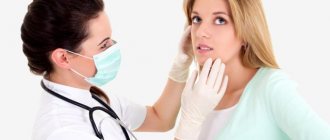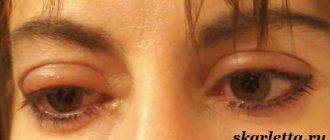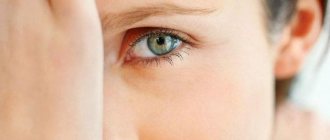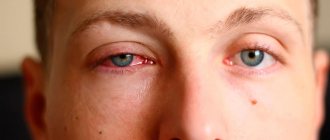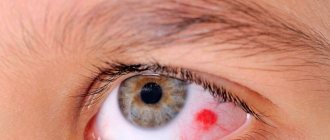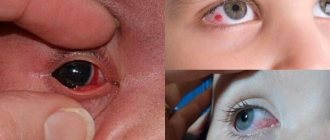Causes of red blood vessels in the eyes
There are many reasons that cause red eyes. These include various inflammations, infections, and excessive visual stress. The eyes turn red when wearing contact lenses if you do not follow the rules of disinfection, the regimen and timing of their wearing. The vessels may become visible if dry eye syndrome develops - with such an ophthalmological problem, a lack of tear fluid is detected, which negatively affects the condition of the capillaries.
Why eyes turn red - reasons:
- colds that occur with fever;
- dry eye syndrome when wearing contact lenses;
- increased visual stress;
- ophthalmological infectious diseases;
- allergic rhinitis, conjunctivitis;
- hypertension - due to increased pressure, blood vessels increase in volume;
- intraocular pressure, glaucoma;
- reaction to the use of medications;
- foreign body, dust, sand getting into the eye;
- hemorrhage as a result of blockage of the retinal veins, its detachment.
Reducing the amount of moisture in the eyes can cause the spread of viruses and infections, and inflammation of the conjunctiva. A healthy person has all the mechanisms to protect against such exposure. Tears contain lysozyme, a protein that has antimicrobial and antiviral effects. If there is little tear fluid, for example, due to working in rooms with functioning climate control equipment, or with increased visual stress at the computer, this can lead to redness of the eyes.
You can eliminate visible eye vessels with the help of whitening drops, which relieve redness and swelling of the conjunctiva, having a vasoconstrictor effect. But the problem will arise again if you ignore the very cause of red eyes.
And this reason may not be harmless at all, because some diseases of the visual organs require serious treatment due to the rapid development of dangerous symptoms. Thus, constantly increased intraocular pressure in glaucoma triggers irreversible processes. The earlier the disease is diagnosed, the better the prognosis.
Why do arteries weaken?
Small blood vessels located in the sclera of the eyes are distinguished by the fact that they have thin walls. Many unfavorable factors can lead to the fact that their structure will be disrupted, they will become thinner and thinner. As a result, blood will begin to flow under the conjunctiva.
Before you think about how to protect your eye capillaries from rupture, you need to find out why this happens in the first place:
- Blood pressure rises. People suffering from hypertension for a long time may notice hemorrhages on the sclera. The thing is that high blood pressure provokes excessive blood supply; small arteries burst under pressure. Sometimes a symptom may indicate the development of hypertension.
- Physical overexertion - frequent strength training, lifting heavy objects. In women, capillaries can burst during childbirth, as there are strong attempts.
- Diseases of an endocrine nature, especially diabetes. The blood vessels become very thin, and this also applies to the eyes.
- Diseases of an ophthalmological nature – keratitis, conjunctivitis. Hemorrhage may be accompanied by other symptoms such as itching and other discomfort.
- Injuries – head bruises, blows to the eye area.
- Eye strain. You may notice redness after working with documents or watching TV for a long time.
- The body's sensitivity to weather conditions.
- You can see that blood vessels have burst after going to a hot bath, as well as after drinking alcoholic beverages.
- Lack of vitamins in the body, especially rutin and ascorbic acid.
- Hemorrhage can occur after taking certain medications that thin the blood.
In children, blood vessels can burst when crying, or at a time when the baby cannot go to the toilet for the most part. A single hemorrhage should not be a concern, but if it is systemic in nature, you should contact a specialist. Simple techniques will help avoid many unpleasant complications.
Factors that cause red eyes
Redness of the whites of the eyes is a common problem, and this makes it seem insignificant. Many people notice that red streaks appear on the whites after a sleepless night, excessive consumption of strong alcoholic beverages, as a result of visual fatigue, and prefer to do nothing to eliminate such symptoms. Meanwhile, alcohol dilates blood vessels, increases blood flow, and then the vessels narrow again and the outflow of blood becomes more difficult, so the capillaries become overfilled with blood, which negatively affects the condition of their walls. The same processes occur when smoking in an unventilated room: blood vessels narrow, blood flow decreases, and dryness appears.
Negative factors affecting the condition of the blood vessels of the eyes:
- external irritants: tobacco smoke, smog, dust, windy weather;
- lack of sleep, bad habits;
- low-quality cosmetics, aerosols (irritation is caused by preservatives, lanolin, zinc oxide, titanium dioxide);
- washing, water procedures using chlorinated water - chlorine disrupts the microflora of the conjunctiva and lacrimal ducts;
- wearing contact lenses with low oxygen permeability parameters - such products prevent the passage of oxygen to the cornea, which affects the health of the visual organs.
To understand why the eyes turn red, you need to know what capillary damage is. The blood vessels do not burst, although many people think so when they see large red islands on the whites of the eyes. Simply due to the dilation of blood vessels, the blood in them becomes visible due to the fact that the walls of the capillaries themselves become thinner. Also, the vessels turn red due to the spread of infection, for example, with viral or bacterial conjunctivitis.
In this case, the fight against redness will be carried out in combination with therapeutic measures aimed at relieving inflammation and eliminating microbes and viruses.
How to remove red blood vessels in the eyes?
You can remove visible red blood vessels in the eyes, if the redness is not associated with colds and ophthalmological diseases, by using anti-inflammatory eye drops. If your eyes are red due to bacterial conjunctivitis, you will need antimicrobial drugs and broad-spectrum antibiotics. Red eyes caused by viruses can be treated with antiviral medications. Drugs such as Zovirax, Lavomax, and Acyclovir are effective against viruses. If the causes of red blood vessels are allergic in origin, you will need antihistamines, which are individually selected by the doctor and written out a prescription. Nowadays, second-generation drugs, without sedation, are more often used.
What else is used for red blood vessels in the eyes? How can you quickly get rid of redness? Redness that appears due to severe fatigue and eye strain, unfortunately, does not go away quickly, but there are effective measures that, when used in complex therapy, can help get rid of visible blood vessels.
Improvement of eyes with weak blood vessels prone to redness:
- the use of eye drops with vitamins that improve nutrition and metabolism in eye tissues, activating recovery processes;
- a course of vitamins for vision - “Taufon Tabs Lutein” with plant carotenoids is suitable, they are recommended for increased visual stress, when working at a computer, impaired twilight vision, constant eye fatigue (prescribed by a doctor);
- massage to relieve swelling of the eyelids - lightly stroking the eyelids with your fingertips improves blood circulation, which helps relieve eye strain;
- whitening vasoconstrictor drops - short-term use of such drugs is allowed when it is necessary to quickly remove redness.
Red eye syndrome occurs when the elasticity of blood vessels decreases and their permeability increases.
To get rid of the problem for a long time, it is necessary to strengthen the blood vessels of the eyes, take medications prescribed by the doctor, and also eliminate the causes of the pathology that affect the appearance of red blood vessels. Red veins are always a clear signal from the body about problems in the blood supply system of the eyeball.
Indications for vasodilation
The narrowing of the lumen of the arteries leads to insufficient blood flow to the tissues they nourish. An ischemic syndrome occurs, accompanied by a severe decrease in organ function and acute vascular disorders. A critical degree of ischemia means tissue death (necrosis), such conditions are life-threatening.
The main causes of vasoconstriction:
- congenital anatomical feature;
- blockage by a blood clot or atherosclerotic plaque;
- inflammation with swelling of the inner membrane;
- compression from the outside by a tumor, scar tissue;
- spasm due to neurological disorders, smoking, hormonal imbalance.
For any of these conditions, the doctor may prescribe drugs to dilate blood vessels as a primary remedy or in complex treatment.
We recommend reading the article about medications for the blood vessels of the head. From it you will learn about which medications are best to take and when, about herbal preparations with complex effects, as well as possible contraindications. And here is more about vascular tone.
Strengthening eye blood vessels
The choroid of the eye is located between the sclera and the retina. Capillaries form a dense vascular network, which becomes visible only in the presence of pathological changes in the vessels and inflammation of any part of the eye. Increased vascular permeability can be caused by infections, fungi, viruses and bacteria. Vessels also dilate due to the action of histamine (with allergies). The result of this effect is red blood vessels in the eyes.
Remember that ignoring disturbances in the blood supply system of the visual organs can lead to dysfunction of the eye structures, decreased visual acuity, especially if redness is accompanied by pain, inflammation, and decreased visibility. Red blood vessels in the eyes become visible due to changes in the strength and elasticity of the capillary walls.
How to strengthen the blood vessels of the eyes:
- taking vitamin complexes with zinc, lutein, copper, iron;
- proper, well-balanced nutrition (eating foods high in vitamins C, K, A, E);
- eye drops, the action of which is aimed at strengthening the walls of blood vessels, improving metabolic processes, stabilizing cell membranes, reducing intraocular pressure, increasing tissue resistance to oxygen deficiency, regulating the biosynthesis of proteins involved in blood clotting (Taurine, Oftagel, Vizin) , "Emoxipin", "Oftan Katahrom").
To strengthen the blood vessels of the eyes, ophthalmologists prescribe drugs with a complex effect, which not only improve blood flow to the organs of vision, but also have an angioprotective effect, strengthen the vascular wall, and eliminate intraocular hemorrhages. If you urgently need to remove redness from the eyes, you can use whitening drops “Okumetil”, “Betadrin”, etc., just use them with caution.
Symptoms
The main symptom of weakened blood vessels is hemorrhage, which can be noticed immediately (see Vessels burst in the eyes: why does this happen?). Bruising occurs at the bottom of the eye or at the top; several damaged arteries can lead to complete redness of the sclera. Many see only external signs, others feel discomfort in the form of the presence of a foreign object.
If the structure of the vessel has been damaged due to increased pressure, the patient may complain of severe headaches, general health will deteriorate, and black spots will appear before the eyes. More often, hemorrhage affects one eye, much less often two.
Depending on the location, several forms can be distinguished:
| Localization | Characteristic |
| Objects are not clearly visible, vision decreases, and there are spots in front of the eyes. Frequently recurring symptoms will lead to decreased visual acuity. | |
| Occurs when the head or eyes are injured. The eyeball moves forward, eye mobility decreases. Objects split into two, pain is present. | |
| The pathology is severe and requires immediate intervention from medical personnel. There are flashes of light before the eyes, vision deteriorates. | |
| In medicine, the condition is called hymepha. It should dissolve within a few days; if this does not happen, you should contact an ophthalmologist. |
The video in this article clearly shows how hemorrhage occurs.
Whitening eye drops: application features
Drops for whitening proteins do an excellent job with the aesthetic task of removing red blood vessels and making the look clean and radiant. Such preparations not only eliminate redness, but also lighten the entire protein if it has a dull, yellow color. The effect of bleaching drops is vasoconstrictive, so their long-term use is not recommended. They can help if your eyes are red due to allergies, fatigue, and you need to look cheerful and fresh.
Whitening drops - action:
- have a slight anti-inflammatory effect;
- remove redness of the eyes, swelling;
- moisturize the eyes;
- The aesthetic effect is quick; within an hour after using the drug, the eyes will brighten.
You should not use whitening drops for more than one week, otherwise addiction will occur and they will no longer be effective. Be careful, these drugs have contraindications, so be sure to consult with your doctor.
Red blood vessels in the eyes: treatment with folk remedies
Folk remedies can really help if the eyes are red and look tired, but pharmaceutical drugs are not at hand. But use such remedies only when prescribed by a doctor. And you are sure that there is no inflammation, infection, and the redness of the eyes is caused only by fatigue and overexertion, but not by an exacerbation of ophthalmic diseases.
Folk remedies for red eyes:
- herbal compresses from chamomile, basil, blue cornflower, flax seeds, oak bark - it is better to use cool liquid or decoctions at room temperature, this is effective for relieving swelling;
- tea lotions - you can use black or green tea bags for compresses;
- applying raw potato circles to the eyelids for 20-30 minutes;
- washing the eyes with cucumber water (prepared from the peel of fresh fruits, which is poured with boiling water and infused for half an hour).
Be especially careful with recipes based on honey and other bee products, which can cause an unwanted allergic reaction even in people who are not prone to allergies. Give preference to medications prescribed by an ophthalmologist. They are safe, and most importantly, they have a quick effect.
Prevention
If redness of the eyes was associated only with increased visual stress and fatigue, and not with the development of an infectious disease, if ophthalmological pathologies were not identified, then preventive measures will help prevent the occurrence of such disorders in the future. Eyes turn red due to hypertension, lack of sleep, unhealthy lifestyle, negative environmental factors (wind, tobacco smoke, working climate control equipment, etc.).
Lack of oxygen also has a negative impact on eye health. There are many reasons why there is not enough oxygen in the tissues: non-compliance with wearing contact lenses, unfavorable environmental conditions, poor circulation. All this affects the general health of a person and the condition of his eyes, which, due to lack of oxygen, quickly get tired, turn red, and swell. To completely get rid of red eye syndrome, it is necessary to follow a set of preventive measures:
- normalization of sleep, rest and work patterns - during sleep, the visual organs rest and recover, so it is important to sleep for at least 7-8 hours;
- visual gymnastics - exercises are aimed at improving metabolism, normalizing blood flow, strengthening the vascular system of the eye;
- the use of moisturizing drops for increased visual stress, wearing contact lenses - choose moisturizing preparations without preservatives, with hyaluronic acid, to create a protective tear film on the surface of the eye, for example, Hilo-Komod drops;
- physical activity, healthy lifestyle - performing physical exercises helps saturate all tissues with oxygen, which has a positive effect on the condition of the blood vessels in the eyes, strengthens them;
- eye protection from ultraviolet radiation - if you wear glasses or lenses, choose products equipped with protective filters, and always wear sunglasses in sunny weather;
- control of visual stress - take breaks while working at the computer, do not let your eyes become overstrained.
It will be much better if you organize your workspace correctly. The better the lighting, the less strain will be on the visual organs. Do not use products for hygiene procedures that may irritate the mucous membrane of the eyes.
Proper, balanced nutrition will also help. Your daily diet should include vegetables and fruits, berries and other foods high in vitamins that are good for the eyes. Give preference to leafy greens, citrus fruits, lean meat and sea fish, fruit drinks and compotes, try to consume less foods with preservatives.
Features of treatment for narrowing of blood vessels of different locations
Many vasodilators have preferential activity for different groups of diseases. This is due to the fact that the structure of adrenergic receptors and the innervation of organs are different.
Peripheral vessels of the legs
To relieve spasm of the arteries of the extremities, mainly drugs based on drotaverine (No-spa) and nicotinic acid are used , as well as drugs that simultaneously have an antiplatelet effect: Trental, Curantil (stop platelet joining).
The most effective medications are analogues of prostaglandin E. Alprostan and Vazaprostan are administered intra-arterially and, in addition to the vasodilator effect, have the following properties:
- improve microcirculation and peripheral blood flow;
- thin the blood;
- protect artery walls from destruction;
- prevent thickening of the inner lining of blood vessels and the deposition of cholesterol on it.
Non-drug methods include:
- electrophoresis;
- diadynamic currents;
- applications of ozokerite and therapeutic mud;
- UHF;
- baths with hydrogen sulfide, radon, pine extract;
- sessions in a pressure chamber (HBO);
- magnetotherapy.
Hearts
An important condition for the treatment of myocardial ischemia is a low-fat diet, smoking cessation, minimizing stress and daily dosed physical activity. For drug therapy, antiplatelet agents (Aspirin), beta blockers (Vasocardin), and cholesterol-lowering drugs (Zocor) are used.
Adding nitrates to therapy helps to significantly reduce the load on the heart due to their vasodilating effect. They primarily relax the veins and promote the accumulation of blood in them. This facilitates the work of the myocardium, reduces its need for additional oxygen, and also helps to redistribute blood flow to areas where it is reduced.
For spasm of coronary vessels due to stress, a course of medicinal plants is recommended. Herbs with a calming effect that can have a positive effect on coronary circulation are shown: lavender flowers, oregano, linden, hawthorn fruits, mint leaves.
Brain
To dilate the cerebral arteries, drugs are used that improve blood flow without developing steal syndrome. These include:
- calcium antagonists: Nimotop, Cinnarizine;
- adrenergic blockers: “Sermion”, “Pronoran”;
- antiplatelet agents with a vasodilating effect: “Curantil”, “Pentoxifylline”;
- angioprotectors: Cavinton, Tanakan.
Medicinal plants that improve cerebral circulation are periwinkle, ginkgo biloba, mistletoe, Baikal skullcap, passionflower, peony, and pine cones.
Cervical vessels
Most often, headaches with cervical osteochondrosis are caused by muscle tension. To reduce it, “Mydocalm” and “Sirdalud” are used. In some cases, antidepressants (Stimuloton) and anticonvulsants (Gabalept) have an effective vasodilator and analgesic effect.
The treatment complex includes physiotherapeutic methods: galvanic collar, electrophoresis, magnetic therapy, sinusoidally modulated currents, darsonval, massage. Physical therapy is highly effective.
Eye
To eliminate spasm of the vessels of the retina, calcium antagonists (Norvasc, Phenigidine) are used, as they increase the overall blood flow. Also shown is “Nikoshpan” to improve microcirculation, herbal products “Vinpocetine”, “Bilobil”.
In cases of spastic conditions due to visual strain, collecting plants helps. It includes blueberries, rosehips and chokeberries in equal parts. Two teaspoons of dry berries are poured into a thermos with 300 ml of boiling water overnight. The next morning, filter and add a teaspoon of aloe juice and honey. The drink is taken 100 ml an hour before meals 3 times a day for at least a month.
